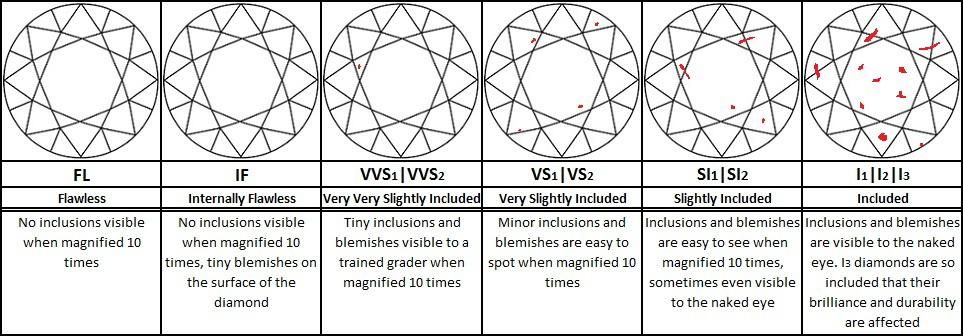For the would be proposer, choosing a diamond is always a daunting task. We always educate our clients in accordance with the Gemological Institute of America's (GIA) grading system, known throughout the diamond industry as 'The 4C's'. The 4C's being colour, clarity, cut & carat. Over the next four weeks, our 'What is' series of blogs will be focusing each week on explaining one of these characteristics in depth as well as a further blog focusing on 'The anatomy of a diamond certificate'. During this post we will be focusing on 'clarity'.
What is diamond clarity?
Diamond clarity refers to the level of marks internally (inclusions) or externally (blemishes). The GIA describes the level of absence or presence of these inclusions or blemishes. Using the GIA clarity scale (shown below), diamonds are graded using this scale. 
The GIA clarity grading scale incorporates 11 individual grades, however some grading laboratories use an extra grade within the Slightly included (SI) spectrum, this grade is known as SI3 which comes directly after the SI2 grade. Although this grade is sometimes used, it is not recognised by the GIA.
GIA clarity scale explained
When grading a diamond for clarity, the GIA uses 10x magnification to assess the clarity, this is done by qualified diamond graders within the GIA's numerous offices all over the globe.
Flawless - No visible marks are noticeable under 10x magnification internally or externally.
Internally Flawless - No internal marks are noticeable under 10x magnification however some exterior marks will be identified.
Very, very slightly included (VVS1 & VVS2) - Some inclusions and blemishes noticeable under 10x magnification however, these are extremely difficult to see.
Very slightly included (VS1 & VS2) - Inclusions and blemishes easier to see using 10x magnification, however marks are nominal.
Slightly included (SI1 & SI2) - Inclusions are easy to see using 10x magnification, however not always noticeable to the naked eye.
Included (I1, I2 & I3) - Inclusions are located easily using 10x magnification and more than likely noticeable to the naked eye. These grades can sometimes disrupt light flow through the diamond.
Types of inclusions and blemishes
There are various different types of inclusions and blemishes which impact a diamond's clarity grading. The following section will explain the different variations and their individual characteristics. On a GIA diamond grading certificate, the diamond plotting diamond will show blemishes in green and inclusions in red, extra facets are denoted using the colour black.
Crystal - A crystal within a diamond is a deposit of minerals, these are sometimes singular or grouped together.
Pinpoint - A pinpoint is a very small crystal, these crystals sometimes when grouped together can form a cloud.
Cloud - As described above, a cloud is a formation of pinpoints grouped together.
Cavity - A cavity is an opening or depression on the surface of the diamond.
Bruise - On the surface of the diamond, a bruise is a chip on the exterior surface.
Feather - A feather is a fracture line that has smaller lines extending away from the main inclusion, giving it a feather like appearance.
Needle - Similar to the above, a needle is a feather without the extending lines.
Chip - A chip is caused normally by the process used in the diamond cutting process. As its name indicates, it is a small chip on the surface of the diamond.
Twinning wisp - A twinning wisp is usually created when the diamond is formed, it is a line of pinpoints or clouds.
Natural - When the diamond is in the process of being polished, sometimes remains of the unpolished diamond can be left on the exterior, a natural is the remnants of this.
Indented natural - As described above, it is a natural but it leaves an indent.
Extra facet - This denotes an extra facet that has been cut onto the diamond, which is not normally part of the standard cutting process.
Note: Visual impact of inclusions varies depending on size and/or location.
Our advice
Diamond grading is not a precise science and will always be an opinion, which should always be remembered when considering a purchase. When purchasing online we recommend that you choose a clarity of VS2 and above to minimise the risk of selecting a diamond with noticeable marks.